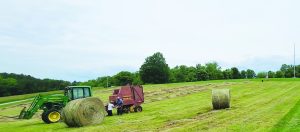The Virginia Department of Environmental Quality, in coordination with the Virginia Drought Monitoring Task Force, recently issued a Drought Advisory Declaration that included a drought warning advisory for 12 Virginia counties and a drought watch for 95 counties and cities. This declaration is intended to advise Virginians in the affected areas to prepare for a potential drought. While recent rainfall has helped in some areas, it has not alleviated conditions for farmers in many areas across the Commonwealth.

The Virginia drought declaration is different from a United States Department of Agriculture (USDA) disaster designation. As conditions warrant, the USDA may issue a natural disaster designation for primary and secondary localities. A drought or severe drought designation is initiated by local USDA Farm Service Agency (FSA) offices and approved by the U.S. Secretary of Agriculture. This type of designation enables farmers in the primary affected counties to be eligible for certain assistance from FSA. Farmers in the counties and cities that are contiguous to the primary drought declaration counties are also eligible to apply for the same drought emergency assistance.
This assistance includes FSA emergency loans. Provided eligibility requirements are met, the FSA will assess each emergency loan application individually and will consider specific circumstances and needs. Farmers in eligible localities have eight months from the date of the disaster declaration to apply for emergency loans.
“I have seen the effects of drought on our Commonwealth and the impacts it has on our agricultural producers firsthand. This marks the second consecutive year that we’ve experienced drought conditions across much of Virginia with over 60 localities in Virginia receiving a USDA disaster designation last year,” said Gov. Glenn Youngkin. “While we look forward to future rainfall, I want our farmers to know that Virginia stands with them. There are government resources available to assist farmers if we do not receive significant rainfall to help the Commonwealth’s crops.”
“Droughts can severely impact agriculture by reducing crop and forage yields, and lead to additional cost for feed, watering, and destocking livestock. Droughts also increase mortality and reduce growth in our forest and increase the risks of forest fires,” said Secretary of Agriculture and Forestry Matthew Lohr. “We can all take steps to help our farmers by conserving water and buying local. We can also help protect our forests by adhering to burn bans, putting out campfires, and taking precautions when using fireworks.”
In addition to the USDA disaster designation, the federal agency has a variety of other programs to assist farmers who may suffer from natural disasters. USDA’s Risk Management Agency works closely with approved insurance providers, who sell and service crop insurance that can provide aid in loss adjustment and prompt claims payments.
Producers should consider risk management coverage or participate in the USDA’s Noninsured Crop Disaster Assistance Program (NAP). Contact your local USDA Farm Service Center to obtain coverage information and to learn about other disaster assistance programs.
Virginia Cooperative Extension has many resources to help before, during and after emergency situations. Farmers should contact their local extension office to access valuable research-based information that may improve the drought resiliency of their operation.
For farmers who may need to sell or buy excess hay due to drought conditions, VDACS hosts a Hay Clearing House through its Division of Marketing. For additional information on hay, please visit www.vdacs.virginia.gov/markets-and-finance-market-news-hay-feed.shtml.



